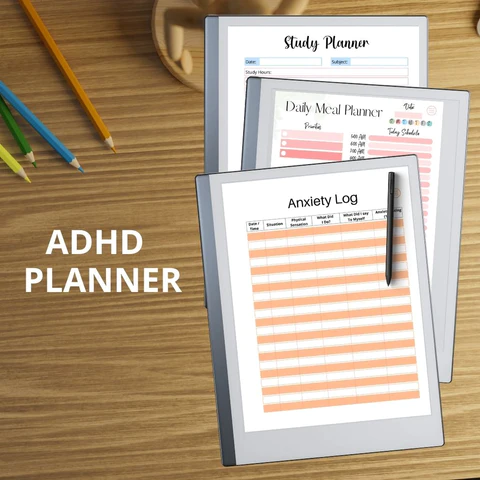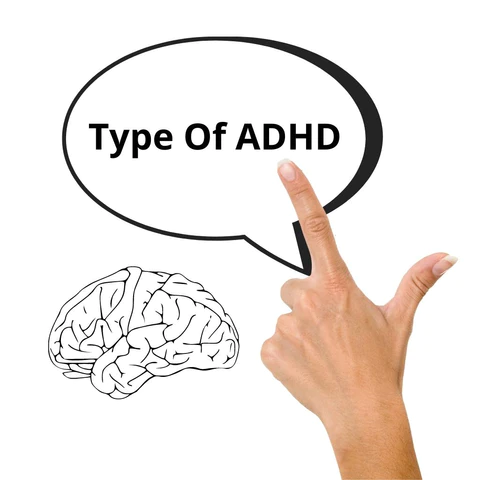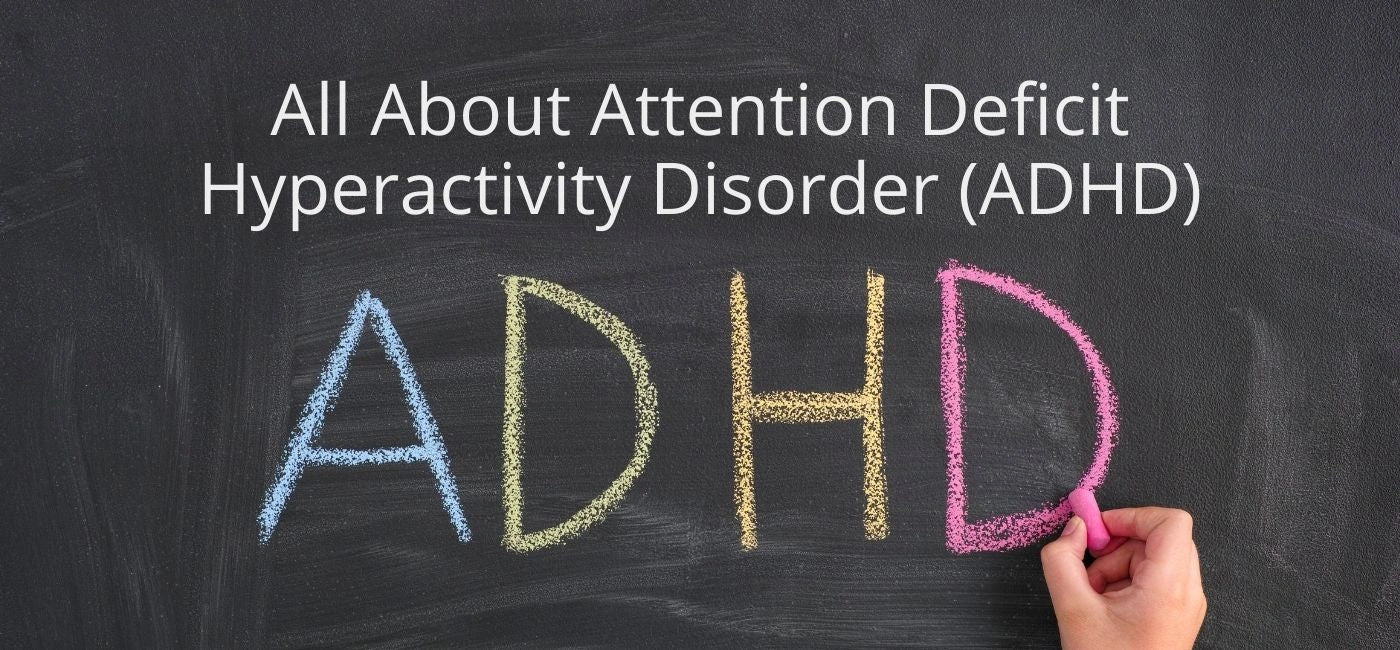What is ADHD? All About Attention Deficit Hyperactivity Disorder
Table of content
- ADHD Definition
- Is ADHD A Disability
- ADHD in children and teens
- ADHD/ADD in Adults
- Type Of ADHD
- ADHD Symptoms
- ADHD Quiz for Children and Teen
- Possible Question list For ADHD:
- Decoding the Overlap Between ADHD and Autism
- What are the Shared mutations?
- A pediatrician role with ADHD:
- Cause of ADHD
- ADHD Treatment
- Conclusion
ADHD Definition
There are general questions like is ADHD a mental illness? Is ADHD genetic? Here You will know all about attention-deficit/hyperactivity disorder (ADHD). It is a behavioral syndrome characterized by inattention and distractibility, restlessness, inability to sit still, and difficulty in concentrating on one thing for any particular period.
Attention-deficit/hyperactivity disorder (ADHD) commonly occurs in adolescents and children. However, adults may also be diagnosed with the condition. ADHD spectrum is three times more common in males than females and occurs in approximately 5 to 7 percent of children worldwide.
Although behaviors characteristic of the syndrome is evident in all cultures, they have garnered the most attention in the United States, where ADHD is among the most commonly diagnosed childhood psychiatric disorders

It is a long-term condition that includes attention difficulty, hyperactivity, and impulsiveness. ADHD often starts in your childhood and can continue into adulthood. It may contribute to lower self-esteem, trouble in relationships, and problems at school or work. Signs include limited attention and hyperactivity. Treatments include medication and psychological therapy.
ADD Vs. ADHD
Studies indicate that anywhere from 6 to 11 percent of children and adolescents in the United States are affected by ADHD. It was not until the mid-1960s that the world physicians began to classify as “mentally deficient” individuals who had difficulty paying attention to demand.
Various terms were named to describe this behavior, minimal brain damage and hyperkinesis. In 1980 the (APA) replaced these terms with attention deficit disorder (ADD). Then in 1987, ADD was linked with hyperactivity, a condition that sometimes accompanies attention disorders but may exist independently. This syndrome was named attention-deficit/hyperactivity disorder, or ADHD.
Is ADHD A Disability?
is adhd considered a disability? ADHD is a disability in the United States under the Rehabilitation Act of 1973, section 504, and many other countries. If the ADHD is severe and hampers a person’s capacity to work or engage in the public sector, it should be called disability. It Is believed to be a protected disability for ADHD.
People suffering from Attention-Deficit Hyperactivity Disorder will repeatedly have frequent behavior problems. You will get reports from school and work situations that often state that a person has not lived up to their potential.
Is ADHD autism?
We can say that Autism spectrum disorder and ADHD spectrum are linked to each other in several ways. But still, ADHD is not on the autism spectrum, but they have some of the same symptoms, and these symptoms increase the chances of having the other.
Difference Between ADHD and autism
Difference between adhd and autism is clear. People with ADHD often have difficulty paying attention to the same thing for too long, and they may get distracted easily. Autistic people may have a limited range of interests. They may seem to obsess over things they enjoy and have a problem focusing on something they have no interest in.
ADHD in children and teens
Childhood is typified by change, both in the child and the immediate environment. Changes in the child’s growth and development are striking. Changes in the environment occur as the surroundings and contacts of a dependent infant become those of a progressively more independent child and adolescent.

ADHD, or attention deficit hyperactivity disorder, is childhood’s most common neurobehavioral disorder. And it is affecting approximately 7% to 8% of all children and youth across the world. The American Academy of Pediatrics (AAP) said that their recent clinical practice guideline for ADHD and ADHD pediatrics is more than the mental health system can handle. It means that ADHD pediatricians are required to step up. You can contact ADHD pediatrics for more details.
Suppose your child has problems with attention, focus, hyperactivity, impulsivity, or some mix of those and is at least four years old. In that case, your first step should be an appointment with your child’s preliminary care doctor.
ADHD condition in children
Attention-Deficit Hyperactivity Disorder (ADHD) is a chronic neuropsychiatric disorder that impacts both children and adults characterized by an inability to focus attention and full actions. ADHD symptoms range from moderate to severe and often affect a person’s capability to complete educational goals, retain a job, and sustain interpersonal associations.
The coping mechanisms of individuals who have ADHD are easily overwhelmed, and their actions often seem chaotic and disorganized to others. Adults affected by ADHD often stumble with depression, anxiety, and substance abuse.
ADHD/ADD in Adults
Many adults with ADHD do not admit they have the disorder. A comprehensive evaluation generally includes a review of past and current manifestations, a medical exam and history, and the use of adult rating scales or checklists. Adults with ADHD are treated with medicine, psychotherapy, or a combination of both. Behavior control techniques, such as minimizing distractions, increasing structure and organization, and involving immediate family members can also be helpful.
Although, for the most part, the ailments of childhood are similar to those of adults, there are several vital disparities. For example, certain specific disorders, such as particular poverty, are unique to children; others, such as acute nephritis—kidney inflammation—are common in children and infrequent in adults.
At the same time, some common conditions in adults are rare in children, including essential hypertension(high blood pressure of unknown cause) and gout. Ultimately, a significant segment of pediatric care concerns treating and preventing congenital anomalies, both functional and structural.
ADHD condition in Adult
It’s a fact that Up to 60% of children diagnosed with ADHD continue to suffer from this condition as grown-ups. Adult ADHD is also called Adult ADHD, Adult ADD, and AADD. Many symptoms of ADHD can be evidenced by people not suffering from the condition, particularly during periods of fatigue or high stress. Individuals affected by ADHD will have exhibited multiple combinations of severe symptoms that continually interfere with their lives since childhood.
Type Of ADHD
It is majorly divided into three parts, as mentioned below.

1. ADHD, combined type:
The most common type of ADHD is characterized by impulsive and hyperactive behaviors and inattention and distractibility.
2. ADHD, impulsive/hyperaCtive type:
Impulsive and hyperactive behaviors characterize the least common type of ADHD without inattention and distractibility.
3. ADHD inattentive and distractible type:
Inattentive and distractible type of ADHD is described predominately by inattention and distractibility without hyperactivity.
Each type of ADHD has one or more characteristics. We can understand it by their behaviors that are often present in ADHD people.
ADHD Symptoms
Let me describe ADHD/ADD symptoms in adults and teens one by one for each type to understand better.
Symptoms of ADHD inattentive type:
ADHD People with symptoms of inattention type may often react as :
- Overlook or neglect details and make seemingly thoughtless mistakes in schoolwork, at work, or during other movements
- Have a problem upholding attention during play or assignments, such as conversations, lectures, or lengthy reading.
- Not appear to attend when spoken word-for-word.
- Find it tough to follow instructions, finish schoolwork, chores, or duties in the workplace, or start tasks but lose direction and get smoothly sidetracked.
- The problem is organizing tasks and activities, doing duties in sequence, keeping materials and belongings in order, managing periods, and meeting deadlines.
- Avoid tasks that demand sustained mental effort, such as homework, or for teens and older adults, designing reports, finishing forms, or reviewing lengthy papers.
- Lose things essential for tasks or activities, such as school supplies, wallets, keys, pencils, books, tools, paperwork, eyeglasses, and cell phones.
- Be easily diverted by irrelevant thoughts or stimuli.
- Be absentminded in daily activities, such as chores, errands, returning calls, and keeping arrangements.
Symptoms of Hyperactivity-Impulsivity Type:
ADHD individuals with symptoms of hyperactivity-impulsivity may often face
- Fiddle and wriggle while seated.
- Depart their seats when staying seated is hoped, such as in the classroom or the office.
- Run, jog around, or climb at inappropriate moments or, in teens and adults, often feel restless.
- Be incompetent to play or entertain in hobbies quietly.
- Be always in motion or on the go, or act as if driven by a motor.
- Speak too.
- Response questions before they are wholly asked, finish other people’s sentences, or utter without waiting for a turn in a discussion.
- Have a problem staying for one’s turn.
- Interrupt or intrude on others, for instance, in discussions, games, or activities.
ADHD symptoms can appear at the ages of 3 and 6 and can continue through juvenility and adulthood. Symptoms of ADHD can be misunderstood for emotional or disciplinary issues or missed entirely in kids who mainly have symptoms of inattention, ushering to a delay in diagnosis. Grown-ups with undiagnosed ADHD may have a record of poor educational performance, troubles at work, or difficult or failed affinities.
ADHD symptoms can transform over some time as a person grows up. In immature children with ADHD, hyperactivity-impulsivity is the most predominant symptom. As a child reaches elementary academy, the sign of inattention may become more prominent and push the child to stumble academically. In juveniles, hyperactivity appears to lessen, and symptoms may more likely contain feelings of restlessness or fidgeting, but inattention and impulsivity may remain. Many people with ADHD also struggle with relationships and antisocial behaviors.
ADHD Quiz for Children and Teen
You may have a bunch of questions for your ADHD child. For example:
- Does my child have the symptoms of ADHD?
- How do I know that my Teen has ADHD?
- What are the parameters to check ADHD?
- How to do an ADD/ADHD test online or at home ?
- How to check ADHD in an adult by test?
- Do I have ADHD Or Do I have an ADHD quiz?
- How can I confirm ADHD?
You are right. Suppose you feel your kid is showing tangible signs of ADHD, or their symptoms appear to be causing them to struggle with their health, well-being, or educational progress. In that case, you may want to use the ADHD quiz as anecdotal proof and further research.
The ADHD quiz includes a list of questions associated with real-life experiences, emotions, and challenges children & teens with ADHD face. It may help parents evaluate if something concerns their kid’s ADHD behavior.
Answering these questions will help you to identify ADHD. Suppose symptoms have only been around for less than six months. In that case, it could be other conditions such as stress, anxiety, or even depression.
It would be best if you remembered that the ADHD adult quiz for 10-18 years old children could not be considered a professional or trustworthy diagnosis, only a signal to consult a physician or pediatrician. To get a proper and adult ADHD assessment, you must visit a fully qualified mental health professional.
Possible Question list For ADHD:
- These are the possible questions an ADHD professional asks, and you should know to check ADHD at home.
- How does your child respond When you ask them to do something they frequently do, such as clean up their room, help around the kitchen, or take out the garbage?
- Do You receive frequent complaints from your child’s teacher about their lack of inattentiveness in class?
- Your child has difficulty sitting still, and they tend to fidget, squirm, and shuffle a lot while sitting.
- Your child is unorganized, which interrupts their activities at home and school. What is their likely response when you give them a schedule or ADHD checklist for adults to follow?
- When given a particular task or activity to perform, did your child pay attention unless it’s something that genuinely interests them?
- A considerable attention deficiency when committing to individual and academic homework becomes challenging.
- Your child cannot fully execute one task before moving on to another unless it’s related to video games or computer games.
- The child has formed a habit of interrupting others. And don’t wait for their turn.
- The child finds it hard to follow instructions and complete work in time.
- When met with a stressful task, your child will give up fast or possibly even before trying.
Decoding the Overlap Between ADHD and Autism
ADHD and autism overlap: Autism and ADHD usually coincide. An estimated 35.5 to 75 percent of children with autism also meet the criteria for ADHD and, contrarily, 20 to 50 percent of children with ADHD for autism. Given the overlapping size, scientists begin to review the relationship between the two conditions and look for common biological origins.
The links could run deep. A study has suggested that autism and ADHD are different manifestations of a single condition with various subtypes, each having an additional time of onset, mix of traits, and progression. ADHD can emerge without signs of autism. Still, autism always occurs with features of ADHD or other conditions.
Genetic studies of both are common. And rare variants begin to shine that risk for autism and ADHD is at least partly shared. The survey investigates the genetic risk of neurodevelopmental disorders. Still, scientists could not make a strong case implicating any particular genetic variant in ADHD and autism. And the Studies so far cannot identify exact risk variants that are shared conclusively.
Risk genes for autism overlap with ADHD People carry rare, dangerous mutations in many of the same genes as people with autism, research of thousands of sequences indicates.
The findings indicate that mutations in these genes increase the risk of both autism and ADHD, says Kerry Satterstrom, a computational biologist.
Scientists have long presumed that autism with ADHD shares genetic roots. Up to 75 percent of people with autism also meet the criteria for ADHD. Both situations are highly heritable and often overlap in families. And some large elisions or duplications of DNA seen in people with autism overlap with those found in people with ADHD.
Yes, it’s true. The new study signifies that the two conditions share a different type of rare mutation, called truncating mutations: single-letter changes in the DNA that result in an incomplete version of a protein. This is a crucial study, says Nikky, the associate professor of psychiatry who was not involved in the assignment. The researchers discovered this overlap by sequencing the genome’s exome, or protein-coding regions, in dried blood samples.
In This study, researchers focused on truncating mutations in genes that rarely carry mutations in the general population — a signal that the changes may be harmful. They found that this mutation crops up more frequently in people with autism and ADHD.
What are the Shared mutations?
Individuals with autism or ADHD usually have other diagnoses, such as intellectual disability or schizophrenia. And the researchers excluded participants with these co-occurring conditions in the studies. And they are still about 1.4 times more harmful, truncating mutations in people with either diagnosis.
The researchers found that the mutations appear just as repeatedly in people with autism as in people with ADHD. A statistical test indicates that the mutations in people with autism or ADHD affect the same genes.
The conclusions are exciting because autism and ADHD share a few common variants. And Common variants are those seen in more than 1% of the population.
A pediatrician role with ADHD:
You will get your answer for can a pediatrician diagnose adhd? And you will also find your answer: who can prescribe adhd medications? According to the AAP, a pediatrician should do so.
- Take a history:
Your doctor should ask questions about the ADHD person and what is going on. Be ready to give details and examples. - A questionnaire about your child:
Your doctor should also give you a questionnaire to your child’s teacher and counselor. - Symptoms Confirmation:
A diagnosis of ADHD and test is made only if a child has signs that are present in more than one location: That would be both home and school for most children. If symptoms are only present in one area, it’s less likely to be ADHD and more likely to be related to that setting. For instance, a child who only has problems at school may have an understanding disability. - Causing a problem in both settings:
Suppose a child is engaged or easily distracted but is getting good moments. In that case, he isn’t causing problems in class and has good relationships in school. At home, there is no problem. And it abides watching, but it could be just personality or temperament.
There are ADHD rating assessment questionnaires, 75 Hard Challenge Tracker, and ADHD Planner Template Bundle. Those have been studied and proven reliable. These tracker and assessment questionnaires can be beneficial in making diagnoses and following a child’s progress over time. - ADHD Screening for your child for other problems:
Some problems can mimic ADHD, such as learning disabilities, depression, or even hearing problems. Besides, children who have ADHD can also have learning disabilities, depression, or substance use. It must be sufficiently questioned and get enough information to be sure. - Discussing treatment options for ADHD:
If a diagnosis of ADHD is made, your pediatrician for ADHD should examine treatment options with you. - For 4- to 5-year-olds:
The best area to start is parent training on managing behavior and getting support in the classroom. Medications should only be considered in this age group if those interventions don’t support them. - For 6- to 12-year-olds:
Along with parent training and behavioral help, medications can aid. Preliminary care providers can prescribe one of the FDA-approved medications for ADHD (clonidine, atomoxetine, guanfacine, or stimulants ). In this group, formal classroom support in the form of Individualized learning Programs or a Medical Planner should be in place. - For 12- to 18-year-olds:
Learning programs and behavioral health support should be continued. The medicines are helpful, but teens should be part of decision-making. Shared decision-making is essential for caring for teens and getting them ready to take on their care when they are grown-ups.
Cause of ADHD
Researchers are unsure what causes ADHD, although many studies suggest that genes play a significant role. Like many other conditions, ADHD probably results from a combination of factors.
Besides genetics, researchers look at possible environmental factors that might raise developmental issues. ADHD researchers say that brain injuries, nutrition, and social environments might play a role in ADHD.
Genetics:
It is seen that ADHD tends to run in families, and, in most cases, it’s assumed the genes you inherit from your parents are a decisive factor in developing the condition. Research indicates that parents and siblings of a person with ADHD are more likely to have ADHD. However, the way ADHD is inherited can be complex and is not thought to be related to a single genetic fault.
There appear to be genetic and neurobiological grounds for ADHD. Usually, adults with the primarily inattentive form of ADHD develop it during preadolescence and adolescence. They were likely reprimanded in elementary or middle school, were invariably distracted, and turned in unfinished work.
However, children with this form of ADHD usually are not hyperactive, and the disorder might have gone unrecognized until they reached juvenility or adulthood. This is true for girls and women cases with inattentive ADHD adults.
Girls may be more quiet and passive than those who do not have the disorder, so they do not stand out in the classroom. Adult women can go undiagnosed until one of their kids is diagnosed with ADHD. At this point, they might recognize similarities in their behavior patterns and seek proficient help.
Brain function, structure, and injury:
Research has identified several possible differences in the brains of individuals with ADHD from those without the disorder. However, the exact significance is not clear. For example, investigations involving brain scans have suggested that some brain areas may be smaller in people with ADHD, whereas others may be more prominent.
Other analyses have suggested that people with ADHD may have an imbalance in the level of neurotransmitters in the brainiac or that these chemicals may not work perfectly.
Environmental Factors:
Researchers are also examining possible environmental factors that might cause developing ADHD. And Researchers are studying ecological trauma.
Pregnancy :
Certain people are also believed to have more risks of ADHD in pregnancy. The babies born prematurely (before the 37th week of pregnancy) or with a low birth weight can be affected by ADHD.
Brain Damage:
If there is brain damage that happens later in life or either a womb or severe head injury may be one of the causes of the ADHD/ADD.
Others:
ADHD People often have other conditions, such as understanding disabilities, anxiety conditions, conduct disorder, depression, and significant misuse.
ADHD Treatment
The parents always have concerns about their child’s treatment. Everyone wants to get the best medicine. When the child is diagnosed with ADHD can be managed with the proper treatment.
There are numerous treatment alternatives, and what performs best can rely on the individual child and family. To find the best options, it is advised that parents work closely with ADHD persons, healthcare providers, therapists, teachers, coaches, and others related to the matter.
ADHD Pediatric Near Me:
You can Ask your local mental health clinic for a therapist, psychologist, or ADHD pediatrician near me.
We have divided it into two parts: medication and non-medication.
Medication Treatments:
For children upto the six years of age, the American Academy of Pediatrics (AAP) advises training in behavior management as the first treatment before any treatment.
And For children of six years above, the recommendations include medication and behavior therapy together.
There are five types of medicine permitted to remedy ADHD. Still, we do not advise you to take yourself without a certified doctor.
Here are some ADHD/ADD medication name lists that are approved by AAP.
1. Methylphenidate
Methylphenidate is the most typically used medicine for ADHD. It belongs to a group of drugs called stimulants, which function by boosting activity in the brain, specifically in areas that play a part in controlling attention and behavior.
Methylphenidate may be offered to adults, teenagers, and children above five years of age with ADHD. The ADHD meds can be taken as directed by your doctors.
Common side effects that can occur of methylphenidate include:
- slight growth in blood pressure and heart speed
- losing of hunger, which can lead to weight loss or weight gain
- problem in sleeping
- headaches, stomach aches
- feeling aggressive, irritable, depressed, anxious, or nervous.
2. Lisdexamfetamine
Lisdexamfetamine is a medicine that stimulates specific regions of the brain. It helps in improving concentration engagement, helps focus attention, and reduces impulsive behavior.
It may be offered to teenagers and children over the age of 5 with ADHD if at least six weeks of treatment with methylphenidate has not helped. Adults can suggest lisdexamfetamine as the first-choice medicine instead of methylphenidate.
Common side effects that can occur of lisdexamfetamine include:
- Reduced appetite, which can lead to weight loss or poor weight gain
- aggression
- drowsiness
- dizziness
- headaches
- diarrhea
- squeamishness and vomiting
3. Dexamfetamine
Dexamfetamine is equivalent to lisdexamfetamine and works in the same way. It may be suggested to adults, teenagers, and kids over the age of 5 with ADHD.
Dexamfetamine can be taken as a tablet 2 to 4 times a day.
Common side effects of dexamphetamine include:
- headaches
- diarrhea
- nausea and vomiting
- declined appetite
- mood swings
- fidgets and aggression
- dizziness
4. Atomoxetine
Atomoxetine performs differently from other ADHD medications. It’s a selective noradrenaline reuptake inhibitor (SNRI), which means it boosts the amount of a chemical in the brain called noradrenaline. This chemical gives messages between brain cells, and improving it can aid attention and help control impulses.
Common side effects of atomoxetine include:
- slight growth in blood pressure and heart rate
- dizziness
- headaches
- irritability
- nausea and vomiting
- stomach aches
- trouble sleeping
Atomoxetine has also been connected to more severe side effects that are important to look out for, including suicidal thoughts and liver damage.
If you fall into the same conditions after taking this medicine, you must go to your doctor.
5. Guanfacine
Guanfacine acts on the part of the brain to enhance attention, and it also decreases blood pressure. It may be suggested to teenagers and children over the age of 5 if it’s not possible to use methylphenidate or lisdexamfetamine. And usually, Guanfacine is not recommended to adults with ADHD and adults with ADHD inattentive type medication. It is taken once a day, in the morning or evening.
The common side effects include:
- Fatigue
- Headache
- Abdominal pain
- Dry mouth
Non- Medication Treatment
Psychological counseling:
Counseling for adult ADHD generally includes psychological counseling (psychotherapy), knowledge about the disorder, and learning skills to succeed.
Psychotherapy may help you:
- To improve your time and organizational skills
- boost Learning to reduce your impulsive behavior
- Develop better problem-solving skills
- Improve your self-esteem
- Learn ways to strengthen relationships with your family, co-workers, and friends
- Develop strategies for controlling your nature.
Cognitive-behavioral therapy:
It teaches specific skills to control your behavior and change negative thinking habits into positive ones. It can support you deal with life challenges, such as academic, job, or relationship problems, and help address other mental health disorders, such as depression.
Behavioral therapy:
The goals of behavior therapy are to memorize or reinforce positive behaviors and eliminate undesirable behaviors. Behavior therapy is a care option that can help reduce misbehavior; it is often helpful to start behavior therapy as soon as possible.
Behavior therapy aims to train someone to monitor their behaviors and then modify them appropriately.
You’ll develop plans for how you conduct in response to certain conditions. These plans often involve some immediate feedback to help in learning appropriate behaviors. For example, a token reward program could be designed to support positive behaviors.
Parent training and education programs:
If your child has ADHD, specially customized parent training and education programs can help you learn specific things. You can design the ways of talking to your child, playing, and working with them to enhance their attention and behavior.
You may also be suggested parent training before your child is formally diagnosed with ADHD. Being suggested a parent training and education program does not mean you have been a lousy parent. It is not like that; it aims to guide parents and carers about behavior management.
And to increase confidence to help your child and improve your relationship.
These are a few recommendations that need to be followed by a parent. Additionally, you can use the Family Medical Bundle Printable Template.
1. Create a Routine:
Try to follow the schedule you have created every day, starting to end. You can take the help of the Self Care Journal Template Get organized external icon. Motivate your child to put school bags, clothing, and toys precisely in the right place every day so that they will be less likely to lose them
2. Off Distractions Points:
Turn off the TV, limit noise, and provide a hygienic workspace when your child is doing homework. Some children with ADHD learn nicely by moving or listening to background music. Track your child with the help of the ADHD Planner Template Bundle and see what works.
3. Limit Choices:
Help your kids feel overcome or overstimulated and offer choices with only a few options. For instance, have them choose between this meal, this toy, or that one.
4. Be clear and straightforward while talking with your child:
Let’s suppose your child knows you listen by describing what you heard them say. Use clear, brief directions when they require you to do something.
5. Help your child plan:
Break down complex tasks into more uncomplicated, briefer steps. For long jobs, starting early and cutting into parts may help to limit stress. Fitness Planner Printable Template is more supportable in this task.
6. Start giving rewards:

Use a 75 Hard Challenge Tracker Template to track positive behaviors, then inform your child that they have done an excellent job. And reward their efforts in other ways.
7. Disciplinary Action:
Reply with appropriate action instead of scolding, shouting, or spanking. Use right directions or remove privileges as consequences for inappropriate behavior Mental Health Planner.
8. Provide a Healthy Lifestyle:
Nutritious food, plenty of physical activity, and adequate sleep are essential. It can help to keep ADHD symptoms from getting more alarming.
9. Professional Training:
Although there are many courses through which you can help your ADHD child at home. But we want to recommend you go for professional help along the way. ADHD specialists can help you develop an effective therapy plan for your child as ADHD responds best to a combination of treatments. We suggest consulting with several specialists.
10. Add more omega-3 fatty acids to the diet:
To find ADHD and autism treatment providers, you may connect primary care physicians, your child’s pediatrician, local hospitals, and polyclinics. You may also search through social media.
Social skills training
Because kids with ADHD usually have difficulty with simple social interactions. And they struggle with low self-esteem. Social skills training is an excellent way to treat that can help your child.
It is commonly conducted in a group environment, and a therapist leads social skills training. A social skills group can teach children to “read” others’ reactions and work more acceptably. The social skills group should be creative to transfer these new skills. Ask your therapist, psychologist, or a local mental health clinic for a social skills group near you.
Conclusion:
Now, you would be able to control ADHD with this extensive information. We have tried to collect every information regarding ADHD that can be useful for you. We believe you have found the answer to your every question. As scientists are yet to research the remedy of ADHD, we still have the opportunity to control it with the help of tips mentioned in the article.
ADHD diagnosis is affected by the numerous members of a child’s community worldwide. We can say like this: A lack of precise knowledge of ADHD is much responsible for it. But the significance of its diagnosis and treatment still exists among multiple community members associations, including parents, teachers, and healthcare providers. More fundamental and clinical research will enhance diagnosis and data for ADHD dissemination methods. Even before further advancement in science, the robust partnerships between scientists and patients with ADHD will be an excellent way to decrease the negative consequences of ADHD disorder.







